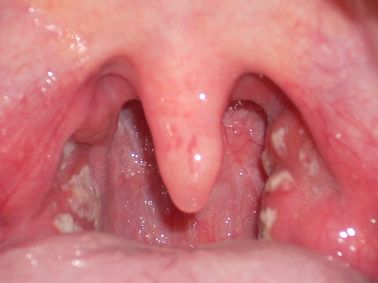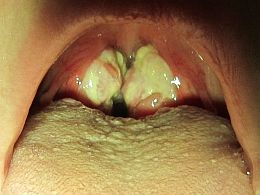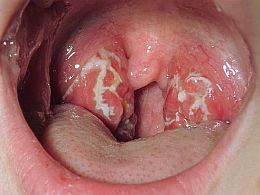White Spots on Throat – Causes and Symptoms
White spots on throat area can be quite alarming, especially if you are experiencing other symptoms. The exact cause varies, but medical conditions like: tonsillitis, mononucleosis, oral thrush and strep throat appear to contribute to it development and progression. White spots on the throat may be accompanied by difficulty swallowing, bad breath, weight loss, chest pain, sore throat and/or fever.
Conditions, associated with white spots on the throat, should not be overlooked, mainly because they can present a significant threat to your health and well-being. It is important to contact your doctor if you notice white spots on your throat, especially if you also have a high fever. This article examines the causes and symptoms associated with white spots on the throat.

Small white patches on the back of the throat
Causes of White Spots on Throat
A variety of factors can contribute to the development of white spots on the throat. It is important to fully understand the various causes then treating this condition. In addition, understanding the possible causes can help lower your risk of developing white spots on the throat.
The following conditions can cause you to have white spots on your throat:
Tonsillitis
Your tonsils consist of the tissues located in the back of your throat. Healthy tonsils are pinkish/red in color, but white spots can develop on them, if you contract tonsillitis. To put it simply, tonsillitis occurs when your tonsils become inflamed and swollen. Your swollen tonsils may also be accompanied by swallowing difficulties, a high fever, a sore, itchy throat, a stiff neck, migraines/headaches and/or raspy voice. If the tonsillitis is caused a bacterial infection, you doctor may prescribe antibiotics, but if the tonsillitis is viral, then home care may be the only treatment required. Chronic episodes of tonsillitis may require a tonsillectomy (removal of your tonsils).
Mononucleosis
Mononucleosis, also known as mono, is a contagious, viral infection that can cause white patches on the throat. This condition can cause symptoms for months and tends to be associated with severe fatigue and a sore throat. If you have mononucleosis, you may notice yellow or white spots on the back of your throat (where your tonsils reside). It is important to note that a strep throat infection that refuses to go away, even with treatment, can signal mononucleosis.
You may experience recurrent rashes, drowsiness, muscle aches, swollen lymph nodes, a lack of appetite and/or a swollen spleen, along with the white spots on the throat, fatigue and sore throat. Treatment may involve learning how to effectively manage your condition and/or any related infections. You can expect your fatigue to subside within a couple months.

White patches on throat caused by Mononucleosis. (Credit: James Heilman, MD)
Oral Thrush
If you happen to notice a white spot on the throat, you may be developing oral thrush. This condition is caused by a yeast infection in the mouth. It is most common in infants, but individuals with autoimmune disorders, low immune systems and/or those taking certain medications like corticosteroids are the most susceptible to oral thrush. If you have oral thrush you will develop white patches on the throat, mouth and/or tongue.
Along with the white patches on the throat, you may also experience a cracked mouth, breaks in the corners of your mouth, reduced taste and/or pain. This condition can quickly spread to your esophagus, if left untreated. Your doctor may treat your condition with an anti-fungal medication. He/she may also suggest that you consume plain yogurt (with live active cultures) to accelerate healing and combat future occurrences.
Strep Throat
A white spot on the throat may be the first sign that you have strep throat, a bacterial throat infection. Strep throat is the most common cause of white patches on the throat. This condition can also cause a yellow or white film and pus-filled white lumps on the tongue, mouth, tonsils and throat. In some cases, harmful bacteria can cause cracks in your mouth and/or on your throat and tonsils.
When you have strep throat, harmful bacteria, called streptococcal, collect in the crevices of your mouth, leading to white spots on the throat, a sore throat, white and red pus-filled lumps on the back of the throat, red spots on the roof of the mouth and/or throat, extreme fatigue, a fever, headaches/migraines, a swollen, stiff neck, vomiting and swallowing difficulties. It is important not to ignore strep throat symptoms because they can lead to serious complications like kidney malfunctions and/or rheumatic fever.
Strep bacteria consists of a hundreds of streptococcal bacteria strains – some more severe than others. If you have strep throat, your doctor will more than likely prescribe antibiotics to accelerate healing. He/she may also prescribe over-the-counter pain relievers and/or medicated throat sprays to ease throat soreness.

A case of Strep throat, culture positve. (Credit: James Heilman, MD)
Symptoms of White Spots on Throat
Here are some common symptoms you might experience:
- Difficulty Swallowing – If you have white spots on the back of your throat, you may have problems swallowing. White spots, caused by a yeast infection, can inflame your throat and restrict your throat passage way, resulting in swallowing difficulties. This symptom may present as a feeling that something is stuck at the back of your throat, reoccurring chest pain, a burning sensation in the throat and/or chest and/or throat pressure following a meal. Moreover, you can experience this symptom when excess candida in the mouth and esophagus causes your throat and/or tonsils to inflame. In severe cases, swallowing difficulties can lead to weight loss.
- Weight Loss – Another symptom that can occur as a result of white spots on the throat is weight loss. As mentioned before, white spots can cause inflammation in the mouth and on the throat and tonsils, which can affect your ability to swallow. Swallowing difficulties coupled with a loss of appetite can lead to weight loss. In addition, if the throat inflammation is caused by an overabundance of yeast, you run the risk of a restricted throat passageway, which can also lead to problems swallowing and weight loss.
- Chest Pain– You may experience chest pain when you have white spots on the back of your throat. It is not uncommon to experience chest pain under the breastbone, where the esophagus is located, when you have candida (an overabundance of bacteria) In fact, your chest pain and pressure may resemble heartburn and, in some cases, angina (heart pain).
- Oral Thrush -Oral thrush (an oral yeast infection) can occur when excess amounts of yeast collect in your mouth and then transfer onto your throat. If you have oral thrush, you may experience white spots on the throat. You may also suffer from throat and/or mouth pain, a loss of taste, white patches on the back of the throat, mouth and/or tongue, breaks at the corners of the mouth and/or bleeding around the gums. Furthermore, if you have oral thrush, your doctor may prescribe an antifungal medication to eradicate your symptoms and prevent future occurrences.
- Sore Throat -A sore throat is often associated with white spots on the back of your throat. A sore throat may cause you to experience pain upon swallowing. Moreover, the white spots can irritate and inflame your throat, which can aggravate your sore throat and lead to loss in appetite.
- Bad Breath -Do not be alarmed if you experience bad breath with your white spots on the throat – it is common. When you have an overgrowth of yeast, bacteria or fungus, it can cause an unpleasant odor in your mouth. Moreover, if you have chronic oral yeast infections, you may be able to identify the white spots and bad breath as symptoms of candida.
- Fever – It may seem strange, but white spots on the back of your throat can also be accompanied by a fever. A fever can occur when a yeast, fungal or bacterial infection spreads from your mouth, to your esophagus and finally into your blood stream.
References:
Centers for Disease Control and Prevention (CDC). (2013). Candidiasis. Retrieved from http://www.cdc.gov/nczved/divisions/dfbmd/#11
Oral Cancer Foundation. (2013). Candida. Retrieved from http://www.oralcancerfoundation.org/dental/candida.htm
-
Advertisement

 Facebook
Facebook  Twitter
Twitter  RSS
RSS







